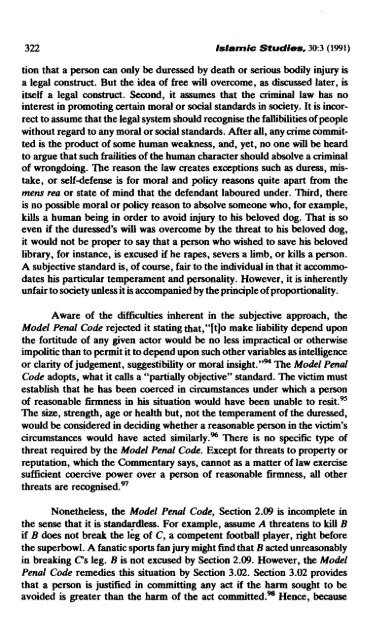LAW OF DURESS IN ISLAMIC LAW AND COMMON LAW: A ...
LAW OF DURESS IN ISLAMIC LAW AND COMMON LAW: A ...
LAW OF DURESS IN ISLAMIC LAW AND COMMON LAW: A ...
You also want an ePaper? Increase the reach of your titles
YUMPU automatically turns print PDFs into web optimized ePapers that Google loves.
322 Islamic Studies, 30:3 (1991)<br />
tion that a person can only be duressed by death or serious bodily injury is<br />
a legal construct. But the idea of free will overcome, as discussed later, is<br />
itself a legal construct. Second, it assumes that the criminal law has no<br />
interest in promoting certain moral or social standards in society. It is incor-<br />
rect to assume that the legal system should recognise the fallibilities of people<br />
without regard to any moral or social standards. After all, any crime commit-<br />
ted is the product of some human weakness, and, yet, no one will be heard<br />
to argue that such frailities of the human character should absolve a criminal<br />
of wrongdoing. The reason the law creates exceptions such as duress, mis-<br />
take, or self-defense is for moral and policy reasons quite apart from the<br />
mem rea or state of mind that the defendant laboured under. Third, there<br />
is no possible moral or policy reason to absolve someone who, for example,<br />
kills a human being in order to avoid injury to his beloved dog. That is so<br />
even if the duressed's will was overcome by the threat to his beloved dog,<br />
it would not be proper to say that a person who wished to save his beloved<br />
library, for instance, is excused if he rapes, severs a limb, or kills a person.<br />
A subjective standard is, of course, fair to the individual in that it accommo-<br />
dates his particular temperament and personality. However, it is inherently<br />
unfair to society unless it is accompanied by the principle of proportionality.<br />
Aware of the difficulties inherent in the subjective approach, the<br />
Model Penal Code rejected it stating that,"[t]o make liability depend upon<br />
the fortitude of any given actor would be no less impractical or otherwise<br />
impolitic than to permit it to depend upon such other variables as intelligence<br />
or clarity of judgement, suggestibility or moral insight."94 The Model Penal<br />
Code adopts, what it calls a "partially objective" standard. The victim must<br />
establish that he has been coerced in circumstances under which a person<br />
of reasonable firmness in his situation would have been unable to resit."<br />
The size, strength, age or health but, not the temperament of the duressed,<br />
would be considered in deciding whether a reasonable person in the victim's<br />
circumstances would have acted similarly.% There is no specific type of<br />
threat required by the Model Penal Code. Except for threats to property or<br />
reputation, which the Commentary says, cannot as a matter of law exercise<br />
sufficient coercive power over a person of reasonable firmness, all other<br />
threats are recogni~ed.~~<br />
Nonetheless, the Model Penal Code, Section 2.09 is incomplete in<br />
the sense that it is standardless. For example, assume A threatens to kill B<br />
if B does not break the lkg of C, a competent football player, right before<br />
the superbowl. A fanatic sports fan jury might find that B acted unreasonably<br />
in breaking Cs leg. B is not excused by Section 2.09. However, the Model<br />
Penal Code remedies this situation by Section 3.02. Section 3.02 provides<br />
that a person is justified in committing any act if the harm sought to be<br />
avoided is greater than the harm of the act committed.% Hence, because
















